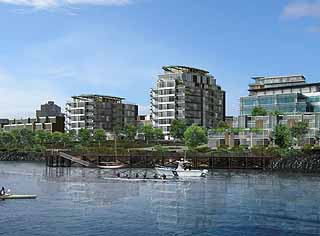
Surveys
DJC.COM
October 26, 2006
Victoria project goes from brown to green
Special to the Journal

Tammemagi
|
A 15-acre site in the heart of Victoria, B.C., is undergoing a revolutionary transformation. Starting as a contaminated brownfield, it is being developed into one of the greenest, smart-growth developments in Canada and a community of the future.
History
During its early years, the site adjacent to the Upper Harbor and downtown was industrial and became contaminated with petrochemicals and toxic heavy metals. About a third of the site consisted of landfill made up of garbage and hazardous materials from mills and paint factories. But a renaissance began when the city issued a request for proposal to remediate and redevelop the site.
The winning team of Vancity, Canada’s largest credit union, and Windmill Developments had a vision to develop a green, triple-bottom-line community, which would have a much smaller environmental footprint than similar developments. They also wanted to create a community that would be vibrant and pleasant to live in. This means the team is using an approach that incorporates not only financial considerations but also environmental and social issues in all its decision-making.
“Dockside Green exemplifies a truly holistic way of life, with smart environmental design, renewable energies and a socially responsible philosophy,” said project spokesperson Joe Van Belleghem.

Image by Busby, Perkins + Will Dockside Green’s first phase, called Synergy, will include four residential buildings adjacent to Victoria, B.C.’s Upper Harbor. |
he project
Dockside Green is the largest redevelopment of city land in Victoria’s history and will comprise 26 buildings totaling 1.3 million square feet and be home to 2,500 people. The project includes residential, retail, office and light-industrial uses, plus numerous public amenities. It will be built over about 10 years.
Cleanup of the contamination has been completed, in effect recycling the property so this major development can occur in the city center rather than sprawling to the outskirts. This will save the municipality considerable costs for new infrastructure such as sewers and roads, as well as reducing reliance on automobiles.
The first phase of development, called Synergy, comprises five- and eight-story condominium blocks plus some townhouses. It is under construction with occupancy set for fall 2007.
The second phase, called Balance, went to market on Sept. 9 and sold its first release in one day. Occupancy is slated for late 2008. Balance consists of 171 condos in two towers of nine and 10 stories.
Both phases have a number of units set aside for affordable housing.
Of the project’s 12 phases, six will consist of condos and six will comprise business and light-industry such as a brewpub, organic bakery and a rowboat manufacturer.
Environment
How will Dockside Green meet its triple-bottom-line goals as economically as possible? Energy will be conserved through cutting-edge technologies and practices, with the goal of having the most energy-efficient buildings in Canada.
“Our first building will be 56 percent more energy-efficient than the Canadian Model energy code, which already sets a very high standard,” Van Belleghem said.
Each condo will be equipped with the most energy-efficient appliances, latest low-E window technology, extra insulation, compact fluorescent lighting, water-efficient plumbing and individual metering.
Other features include Asian bamboo flooring, wood obtained by underwater logging of hydro reservoirs, rainwater-storage tanks on balconies, motion-sensing light switches and high use of recycled materials, such as concrete with about 40 percent fly ash content.
The project is also targeting LEED platinum status, the highest possible. Dockside Green will be the first community in North America to achieve this prestigious but challenging designation. The developer will pay financial penalties of up to $1 million should the certification not be achieved.
Dockside Green will also treat all of its sewage on site, setting an example for a city that is regularly criticized for its practice of dumping raw sewage into the ocean. The sewage plant will have a membrane bioreactor system developed by Zenon Environmental that will use treated water for ponds, toilets and irrigation, saving over 70 million gallons of potable water annually.
Another bold initiative is Dockside Green’s plan to heat the complex and perhaps some nearby buildings using a system developed by Nexterra Energy that converts waste wood biomass into a clean-burning fuel called syngas. Similar district heating methods are relatively common in Europe but rarely used in North America.
The goal is to dramatically reduce greenhouse gas emissions, making Dockside Green one of the first greenhouse gas-neutral communities, as well as reduce costs.
Lifestyle
Dockside Green encompasses much more than environmental friendliness. Located in one of the most attractive cities and climates in Canada, it will offer a vibrant and pleasant lifestyle. It is located on the harbor with all its entertaining marine traffic, from ships to yachts and kayaks, and is within walking distance to Victoria’s core with its shops, theaters and restaurants.
The community will be pedestrian friendly and designed to minimize the need for cars. A major bike path runs adjacent to Dockside Green, a car-share program and mini transit system will be put in place and harbor ferries will call at the wharf. Public amenities — a greenway with flowing creeks and ponds, community plaza, amphitheater, walkways, pedestrian pier and boat launch, and a sustainability center — will be introduced within the first five years of construction.
“The city and community and were involved from the beginning. They helped us design this project,” Van Belleghem said.
Dockside Green’s visionary standard for future development has not gone unnoticed. To date, Dockside Green has received awards from the Canadian Urban Institute, the Planning Institute of British Columbia, the Canadian Institute of Planners, Canadian Architect magazine, SmartGrowth BC and the Royal Architectural Institute of Canada.
Furthermore, British Columbia Environment Minister Barry Penner called Dockside Green “one of the most environmentally progressive urban developments in the history of Canada.”
Most importantly, the public has spoken. In December 2005, when Synergy went to market, 85 percent of the units were sold in the first three hours.
Dockside Green demonstrates that with bold planning and vision, urban development can protect the environment while also providing a vibrant, rewarding lifestyle.
Dr. Hans Tammemagi is a consultant, author and certified environmental auditor specializing in environmental science and waste management. He has audited the Canadian Parliament buildings, Supreme Court and many more.
Other Stories:
- School’s design reflects its humanist curriculum
- Should design firms grow and change?
- Retail plays a bigger role in mixed-use
- In with the old, in with the new
- Designers bet urban dwellers want more
- Dream team designs downtown penthouses
- Designing a cancer center for 4 competitors
- Healthy buildings’ role in organic modernism
- Queen Anne readies for icons old and new
- Keeping the bad guys out of banks
- Surviving today’s tough bid climate
- Why marketing during the good times is critical
- Getting creative with your feasibility analyses
- Hotels and condos: mixed-use matrimony
- Seattle’s waterfront: 100 years of hidden history
Copyright ©2009 Seattle Daily Journal and DJC.COM.
Comments? Questions? Contact us.